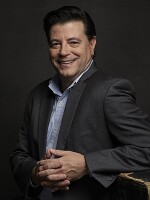Three new exhibits in Connecticut are celebrating the work of artist Leo Jensen (1926-2019). Jensen lived in the Ivoryton section of Essex, and was one of the vanguards of the Pop Art movement in the early 1960s, along with artists like Andy Warhol and Roy Lichtenstein. Pop Art found inspiration in advertising, comic books and popular culture.
Leo Jensen was already an established abstract impressionist painter when Pop Art came along, and he was immediately drawn to the new genre.
“After a certain point, you know, he was really interested in how art and popular culture could speak to one another,” said Amy Kurtz Lansing, curator of the Florence Griswold Museum in Old Lyme. “I think it just resonated with his way of thinking and he helped define it by introducing the idea that art is not just an object you look at, but something you interact with, it’s art as an event.”
One such work on display in the Florence Griswold Museum’s exhibit “Fun and Games? Leo Jensen’s Pop Art,” is his 1964 mixed media sculpture “Secrets of a Home Run Hitter.” A television depicts a baseball player in a shaving commercial, which is surrounded by the trappings of commercialism — boxes of Wheaties cereal, Coca-Cola bottles and beer cans.

“And so you have to wonder, what is the secret of the home run hitter? Is it that he's really good at sports? Or is it that he eats Wheaties and drinks Coca-Cola and shaves with a certain razor?” Lansing said. “Jensen, I think, is making us think about those kinds of things. We don't tend to have those deep thoughts while we're watching sports on television, but he kind of prompts us to think a little bit further about who we are celebrating.”
Jensen grew up in the Midwest during the depression. He and his family worked in the circus and rodeo, an early influence on the young artist.
“A lot of his practical skills came out of his time in the circus,” Lansing said. “He painted posters and carved replacement things for circus wagons. He is very conscious of using some of the same imagery. He has a work called “Signs on the Midway,” which includes flashing lights like a game.”
While the Pop Art movement came and went, Lansing said Jensen continued creating in the pop-art style, culminating in the bronze frogs perched on giant spools overlooking the Thread City Crossing Bridge in Willimantic.
“The idea that you could have a bridge with frogs on it seems kind of crazy. And yet, putting that preconception aside, Jensen was able to create something that expressed who they were and what their place meant to them. And he did it with a sense of humor. The frog is not really paying attention to the world around it, you know, it looks kind of bored, just like a frog would. So, he registers both the natural feeling of a frog or the natural look of a frog, and then how absurd it would be if it were sitting on a spool on a bridge.”
Jensen’s work can be seen in three Connecticut exhibitions. The Florence Griswold Museum in Old Lyme’s exhibit, “Fun and Games? Leo Jensen’s Pop Art” runs through May 19. “Art in Play: Leo Jensen” runs through April 14 at the Lyman Allyn Museum in New London. Works by Jensen are also featured in the exhibit “Avant Colony: Unearthing the Westbrook Gallery” at the Ely Center for Contemporary Art, which runs through March 31.





